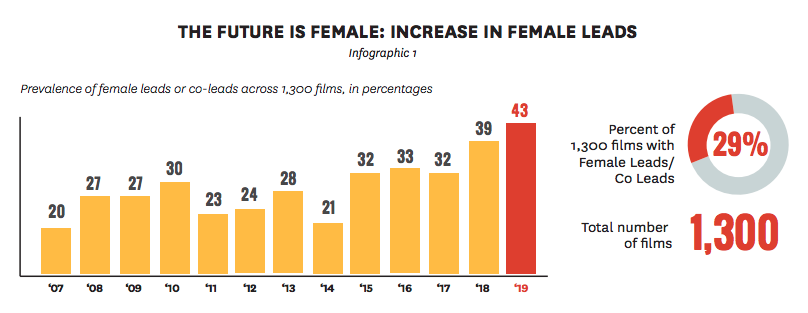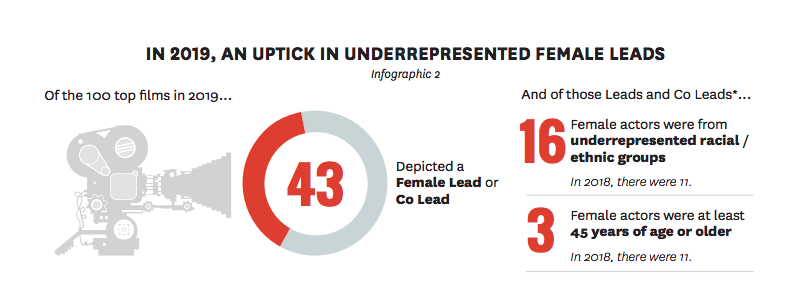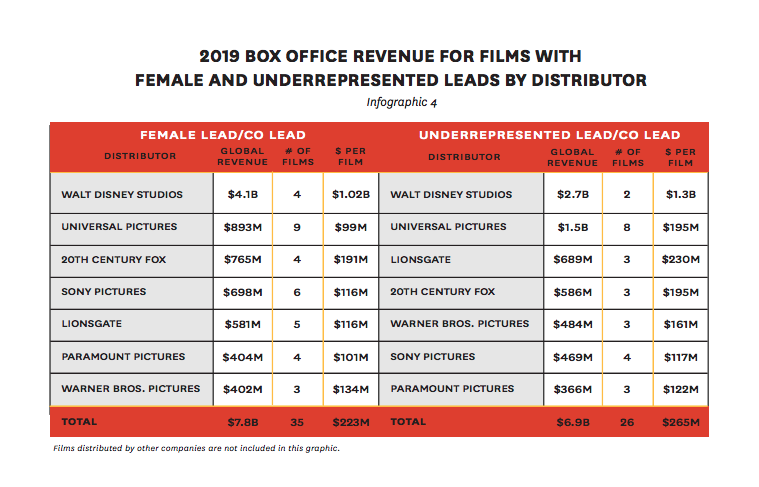The Oscars and BAFTAs are still #SoWhite, but show business seems to be upping its on-screen inclusivity as of late. A new research brief from the USC Annenberg Inclusion Initiative found that “2019 was a banner year for inclusion among leading characters in popular film.” The number of women and people of color leads/co-leads in the top-grossing 100 films both hit new highs.
“Inequality Across 1,300 Popular Films” considered the gender, race, and age of leading and co-leading characters in the top films from 2007-2019. Marking a 13-year high, 43 of the top 100 films last year featured a female lead or co-lead. In 2018, that figure was 39. This means, that for the first time ever, “the percentage of leads/co-leads in popular film approximates the percentage of leads/co-leads in television.”
Meanwhile, 31 films were led or co-led by a person of color in 2019, another 13-year high and an increase from the previous year’s 27. Women of color led or co-led 16 top films in 2019, versus 2018’s 11.
Looking at the big picture, however, the numbers aren’t as encouraging. Overall, women and girls led or co-led only 29 percent of the top 1,300 films from 2007-2019, and people of color just 17 percent. Obviously, it’s vital that Hollywood maintains its forward momentum and keeps making inclusive movies.
“It is clear that Hollywood is taking steps to create more inclusive stories and that those films are connecting with audiences,” said Dr. Stacy L. Smith, founder of the Inclusion Initiative. “Yet, there is also a very obvious disconnect between what sells tickets and what garners awards points to a systemic bias at cultural institutions like the BAFTAs or the Academy Awards. After another year in which the major studios increased their output of films with female and underrepresented leads or co leads, it is critical to recognize that talent is not limited by gender or race/ethnicity,” she stressed.
Despite the gains in inclusion popular film made last year, the news is not all good. The number of underrepresented female leads and co-leads increased, but there were still plenty of women and girls who went completely ignored. “No girls or women identifying as Native American/Alaskan Native, Middle Eastern/North African, or Native Hawaiian/Pacific Islander filled a leading or co-leading role in 2019,” per the research brief.
Older women were also largely shut out of last year’s top films. Just three movies featured a woman lead/co-lead aged 45 or older. Only one of 2019’s female leads/co-leads was a woman of color aged 45 or older. These figures are a steep decline from the previous year, in which 11 films were led or co-led by women who were at least 45.
Turning to distributors, “Inequality Across 1,300 Popular Films” found that Universal Pictures was the top performer in terms of spotlighting women and underrepresented leads/co-leads. In 2019 it released nine films centered on girls or women, and eight films featuring leads/co-leads of color. In terms of financial impact, however, Disney took the crown. It netted “more than $4 billion in receipts for 4 female led/co led films in 2019,” more than four times as much as Universal’s female-driven titles. It’s a similar story for Disney’s racially diverse pics: it earned “$2.7 billion for its 2 films [featuring people of color leads/co-leads], while Universal Pictures brought in $1.5 billion for its 8 movies.”
These numbers suggest Hollywood is starting to take on-screen representation seriously — and is making money from its efforts. That’s definitely worth celebrating, but as Smith rightly pointed out, the industry needs to start showing the same interest in behind-the-scenes inclusion.
“The results of this brief reveal that studios are putting money behind inclusion and that the box office is responding in kind. Despite the increase in female-led movies last year, only 12 of 2019’s top-grossing directors were women,” she said. “As the number of films starring women continues to increase, it is critical that women get the opportunity to tell these stories — as well as those with male leads.”
Check out the entire “Inequality Across 1,300 Popular Films” research brief here.











